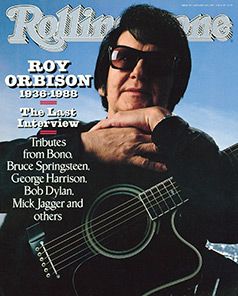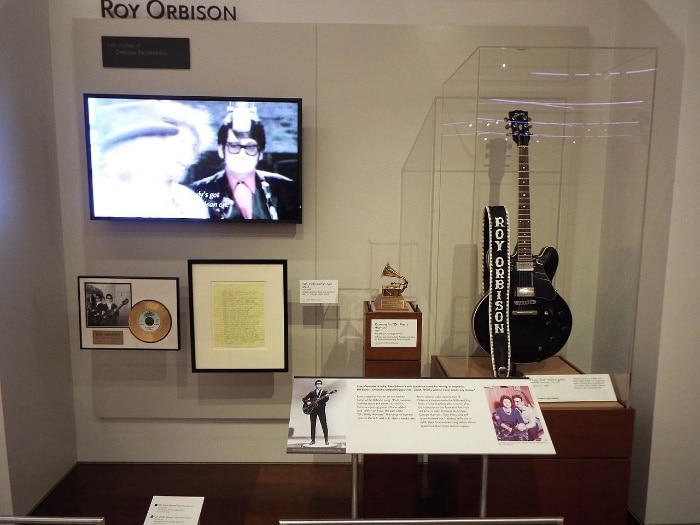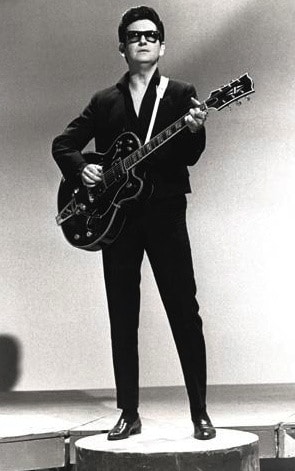 Roy Orbison was an American singer, songwriter, and musician known for his powerful voice, wide vocal range, impassioned singing style, complex song structures, and dark, emotional ballads. The combination led many critics to describe his music as operatic, nicknaming him “the Caruso of Rock” and “the Big O”. While most male rock-and-roll performers in the 1950s and 1960s projected a defiant masculinity, many of Orbison’s songs instead conveyed vulnerability. His voice ranged from baritone to tenor, and music scholars have suggested that he had a three- or four-octave range. During performances, he was known for standing still and solitary, and for wearing black clothes, to match his dyed jet-black hair and dark sunglasses, which lent an air of mystery to his persona.
Roy Orbison was an American singer, songwriter, and musician known for his powerful voice, wide vocal range, impassioned singing style, complex song structures, and dark, emotional ballads. The combination led many critics to describe his music as operatic, nicknaming him “the Caruso of Rock” and “the Big O”. While most male rock-and-roll performers in the 1950s and 1960s projected a defiant masculinity, many of Orbison’s songs instead conveyed vulnerability. His voice ranged from baritone to tenor, and music scholars have suggested that he had a three- or four-octave range. During performances, he was known for standing still and solitary, and for wearing black clothes, to match his dyed jet-black hair and dark sunglasses, which lent an air of mystery to his persona.
Born in Texas, Orbison began singing in a rockabilly and country-and-western band in high school. He was signed by Sam Phillips, of Sun Records, in 1956, but his greatest success came with Monument Records. From 1960 to 1966, 22 of his singles reached the Billboard Top 40, and he wrote or co-wrote almost all that rose to the Top 10, including “Only the Lonely” (1960), “Running Scared” (1961), “Crying” (1961), “In Dreams” (1963), and “Oh, Pretty Woman” (1964). Soon afterward, Orbison was struck by several personal tragedies while his record sales declined. In the 1980s, he experienced a resurgence in popularity through the success of several cover versions of his songs, and in 1988, co-founded the Traveling Wilburys, a rock supergroup with George Harrison, Bob Dylan, Tom Petty, and Jeff Lynne. He died of a heart attack later that year, at the age of 52. One month later, his song “You Got It” (1989), co-written with Lynne and Petty, was released as a solo single and became his first to break the U.S. Top 10 in 25 years.
His honors include inductions into the Rock and Roll Hall of Fame in 1987, the Nashville Songwriters Hall of Fame in the same year, and the Songwriters Hall of Fame in 1989. Rolling Stone placed him at number 37 on their list of the “Greatest Artists of All Time” and number 13 on their list of the “100 Greatest Singers of All Time’.
Early life
Roy Kelton Orbison was born in Vernon, Texas, the middle son of Orbie Lee Orbison (1913–1984), an oil well driller and car mechanic, and Nadine Vesta Shults (July 25, 1913 – May 28, 1992), a nurse. Both of his parents were unemployed during the Great Depression, and searching for work, moved the family to Fort Worth in 1942. He attended Denver Avenue Elementary School until a polio scare prompted the family to return to Vernon. Later, in 1946, they moved to Wink, Texas. Orbison later described life in Wink as “football, oil fields, oil, grease, and sand” and expressed relief that he was able to leave the desolate town. All the Orbison children were afflicted with poor eyesight; Roy used thick corrective lenses from an early age. He was not confident about his appearance and began dyeing his nearly-white hair black when he was still young. He was quiet, self-effacing, and remarkably polite and obliging—a product, biographer Alan Clayson wrote, of his Southern upbringing. He was readily available to sing, however, and often became the focus of attention when he did. He considered his voice memorable, if not great.
On Roy’s sixth birthday, his father gave him a guitar. He later recalled that by the age of seven, “I was finished, you know, for anything else”; music would be his life. His major musical influence as a youth was country music. He was particularly moved by Lefty Frizzell’s singing, with its slurred syllables. (When he later joined the British-American supergroup the Traveling Wilburys, he adopted the name “Lefty” Wilbury). He also enjoyed Hank Williams and Jimmie Rodgers. One of the first musicians he heard in person was Ernest Tubb, who was playing on the back of a flatbed truck in Fort Worth. In West Texas, he was exposed to many forms of music: “sepia” (a euphemism for rhythm and blues), Tex-Mex, the orchestral arrangements of Mantovani, and cajun. The cajun favorite “Jole Blon” was one of the first songs he sang in public. At the age of eight, he began singing on a local radio show. By the late 1940s, he was the show’s host.
In high school, Orbison and some friends formed a band, the Wink Westerners. They played country standards and Glenn Miller songs at local honky-tonks and had a weekly radio show on KERB in Kermit. When they were offered $400 to play at a dance, Orbison realized that he could make a living in music. After graduating from Wink High School, he enrolled at North Texas State College in Denton, planning to study geology so that he could secure work in the oil fields if music did not pay. Orbison heard that his North Texas State schoolmate Pat Boone had signed a record deal, which further strengthened his resolve to become a professional musician. While at North Texas State College, Roy heard a song called “Ooby Dooby”, composed by Dick Penner and Wade Moore in mere minutes atop a fraternity house at the college, and after his first year of college, he returned to Wink with “Ooby Dooby” in hand and continued performing with the Wink Westerners. Orbison moved to Odessa, Texas, and enrolled in Odessa Junior College. As two members of the band quit, one to attend school elsewhere and one to join the Navy, two new members were added to the group, who won a talent contest and obtained their own television show on KMID-TV in Midland, Texas. The Wink Westerners kept performing on local TV, played dances on the weekends, and attended college during the day.
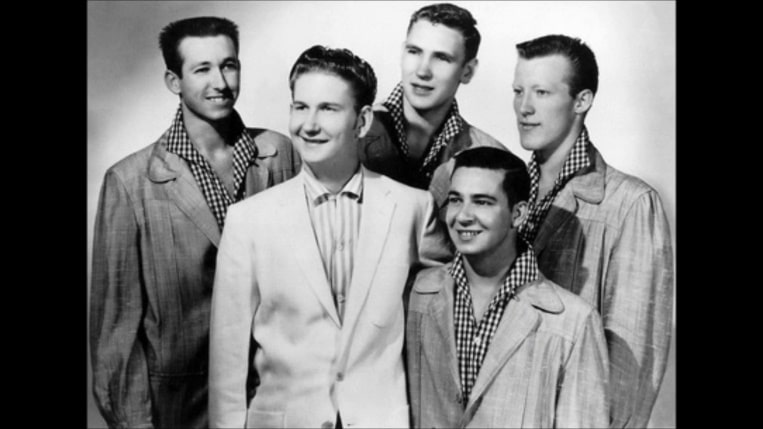
While living in Odessa, Orbison saw a performance by Elvis Presley, who was only a year older and a rising star. Johnny Cash toured the area in 1955 and 1956, appearing on the same local TV show as the Wink Westerners, and suggested that Orbison approach Sam Phillips at Sun Records, the home of rockabilly artists Presley, Carl Perkins, Jerry Lee Lewis (in late 1956), and Cash. Orbison telephoned Phillips and during their conversation was curtly told, “Johnny Cash doesn’t run my record company!” The success of their KMID television show got them another show on KOSA-TV, and they changed their name to the Teen Kings, as they were appealing more and more to a younger audience. Due to the initial rejection from Sam Phillips, the Teen Kings recorded “Ooby Dooby” for the Odessa-based Je–Wel label. According to the official Roy Orbison discography by Marcel Riesco, this was the first release by Orbison in March 1956. Phillips was impressed with the song, after the local record store owner Poppa Holifield played it for him over the telephone, and offered the Teen Kings a contract in 1956.
1956–59: Sun Records and Acuff-Rose
The Teen Kings went to Sun Studio in Memphis, where Phillips wanted to record “Ooby Dooby” again, in his studio. The song was released on Sun 242 in May 1956. and broke into the Billboard Hot 100, peaking at number 59 and selling 200,000 copies. The Teen Kings toured with Sonny James, Johnny Horton, Carl Perkins, and Cash. Much influenced by Elvis Presley, Orbison performed frenetically, doing “everything we could to get applause because we had only one hit record”. The Teen Kings also began writing songs in a rockabilly style, including “Go! Go! Go!” and “Rockhouse”. The band ultimately split over disputed writing credits and royalties, but Orbison stayed in Memphis and asked his 16-year-old girlfriend, Claudette Frady, to join him there. They stayed in Phillips’s home, sleeping in separate rooms. In the studio, Orbison concentrated on the mechanics of recording. Phillips remembered being much more impressed with Orbison’s mastery of the guitar than with his voice. A ballad Orbison wrote, “The Clown”, met with a lukewarm response; after hearing it, Sun Records producer Jack Clement told Orbison that he would never make it as a ballad singer.
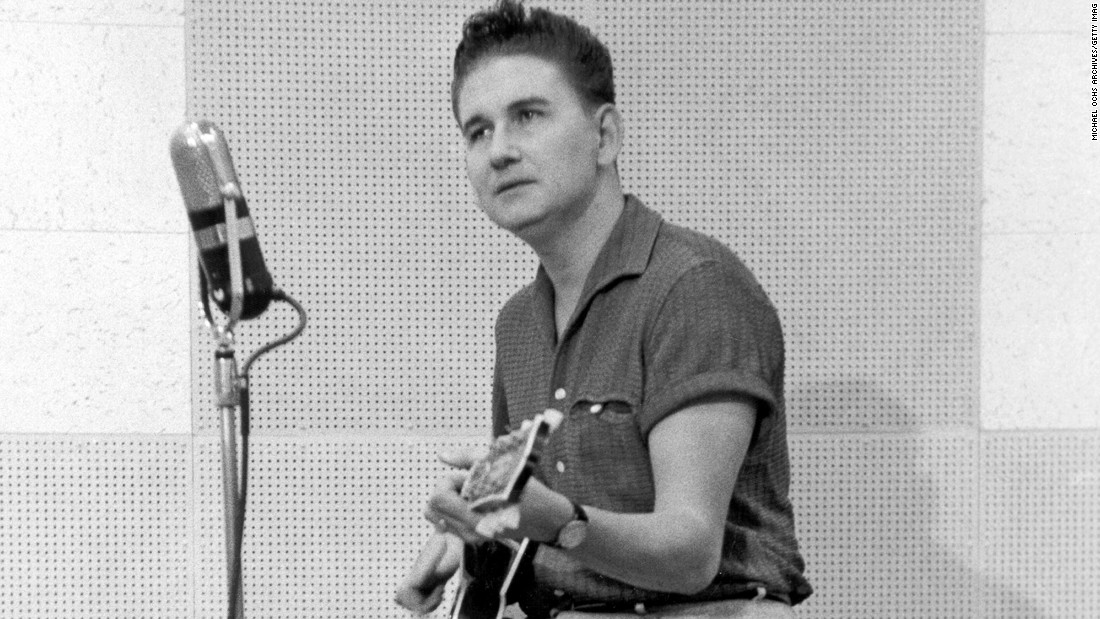
Orbison had some success at Sun Records, however, and was introduced to Elvis Presley’s social circle, once going to pick up a date for Presley in his purple Cadillac. Orbison wrote “Claudette”—about Claudette Frady whom he married in 1957—and the Everly Brothers recorded it for their subsequent release as the B-side of their smash hit “All I Have to Do Is Dream”. The first, and perhaps only, royalties Orbison earned from Sun Records enabled him to make a down payment on his own Cadillac. Increasingly frustrated at Sun, he gradually stopped recording. He toured music circuits around Texas and then quit performing for seven months in 1958 after touring with Patsy Cline, Eddie Cochran, and Gene Vincent.
For a brief period in the late 1950s, Orbison made his living at Acuff-Rose, a songwriting firm concentrating mainly on country music. After spending an entire day writing a song, he would make several demonstration tapes at a time and send them to Wesley Rose, who would try to find musical acts to record them. Orbison attempted to sell to RCA Victor his recordings of songs by other writers, working with and being in awe of Chet Atkins, who had played guitar with Presley. One song he tried was “Seems to Me”, by Boudleaux Bryant. Bryant’s impression of Orbison was of “a timid, shy kid who seemed to be rather befuddled by the whole music scene. I remember the way he sang then—softly, prettily but almost bashfully, as if someone might be disturbed by his efforts and reprimand him.”
Playing shows late into the night and living with his wife and young child in his tiny apartment, Orbison often sought refuge by taking his guitar to his car and writing songs there. The songwriter Joe Melson, an acquaintance of Orbison’s, tapped on his car window one day in Texas in 1958, and the two decided to try to write some songs together. In three recording sessions in 1958 and 1959, Orbison recorded seven songs at RCA Nashville, with Atkins producing, but only two singles were judged worthy of release by RCA; Wesley Rose brought Orbison to the attention of the producer Fred Foster at Monument Records.
1960–64: Monument Records
Early singles
Orbison was one of the first recording artists to popularize the “Nashville sound”, doing so with a group of session musicians known as the A-Team: guitarists Grady Martin, Harold Bradley, Fred Carter, Jr., and Ray Edenton; bassist Bob Moore; pianists Floyd Cramer or Hargus “Pig” Robbins; drummer Buddy Harman; and backup vocals by the Jordanaires or the Anita Kerr Singers. The Nashville sound was developed by producers Chet Atkins, Owen Bradley (who worked closely with Patsy Cline), Sam Phillips, and Fred Foster. In his first session for Monument in Nashville, Orbison recorded a song that RCA had refused, “Paper Boy”, backed by “With the Bug”, but neither charted.
According to musician and author Albin Zak, the studio (with sound engineer Bill Porter, who experimented with close miking the doo-wop backing singers), the production by Foster, and the accompanying musicians gave Orbison’s music a “polished, professional sound … finally allow Orbison’s stylistic inclinations free rein”. To augment the Nashville sound, Orbison requested a string section in the studio. With this combination, he recorded three new songs, the most notable of which was “Uptown”, written with Joe Melson. Impressed with the results, Melson later recalled, “We stood in the studio, listening to the playbacks, and thought it was the most beautiful sound in the world.” The Rolling Stone Illustrated History of Rock and Roll states that the music Orbison made in Nashville “brought a new splendor to rock”, and compared the melodramatic effects of the orchestral accompaniment to the musical productions of Phil Spector.
“Uptown” reached only number 72 on the Billboard Top 100, and Orbison set his sights on negotiating a contract with an upscale nightclub somewhere. His initial success came just as the ’50s rock-and-roll era was winding down. Elvis Presley was serving in the US Army, Jerry Lee Lewis had become disgraced after marrying his 13-year-old cousin, and Buddy Holly had died in a plane crash. Starting in 1960, the charts in the United States came to be dominated by teen idols, novelty acts, and Motown girl groups.

1960–62
Experimenting with a new sound, Orbison and Joe Melson wrote a song in early 1960 which, using elements from “Uptown”, and another song they had written called “Come Back to Me (My Love)”, employed strings and the Anita Kerr doo-wop backing singers. It also featured a note hit by Orbison in falsetto that showcased a powerful voice which, according to biographer Clayson, “came not from his throat but deeper within”. The song was “Only the Lonely”. Orbison and Melson tried to pitch it to Elvis Presley and the Everly Brothers, but were turned down. They instead recorded the song at RCA’s Nashville studio, with sound engineer Bill Porter trying a completely new strategy, building the mix from the top down rather than from the bottom up, beginning with close-miked backing vocals in the foreground, and ending with the rhythm section soft in the background. This combination became Orbison’s trademark sound.
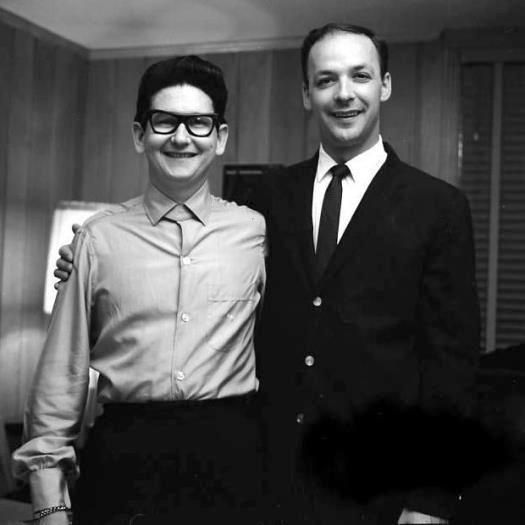
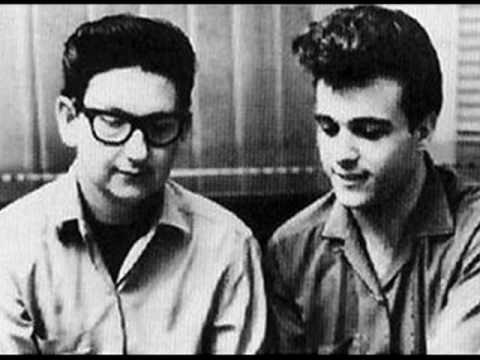
“Only the Lonely” shot to number two on the Billboard Hot 100 and hit number one in the UK and Australia. According to Orbison, the subsequent songs he wrote with Melson during this period were constructed with his voice in mind, specifically to showcase its range and power. He told Rolling Stone in 1988, “I liked the sound of [my voice]. I liked making it sing, making the voice ring, and I just kept doing it. And I think that somewhere between the time of “Ooby Dooby” and “Only the Lonely”, it kind of turned into a good voice.” Its success transformed Orbison into an overnight star and he appeared on Dick Clark’s Saturday Night Beechnut Show out of New York City. When Presley heard “Only the Lonely” for the first time, he bought a box of copies to pass to his friends. Melson and Orbison followed it with the more complex “Blue Angel”, which peaked at number nine in the US and number 11 in the UK. “I’m Hurtin'”, with “I Can’t Stop Loving You” as the B-side, rose to number 27 in the US, but failed to chart in the UK.
Orbison was now able to move to Nashville permanently with his wife Claudette and two sons Roy DeWayne and Anthony King. Back in the studio, seeking a change from the pop sound of “Only the Lonely” and “I’m Hurtin'”, Orbison worked on a new song, “Running Scared”, based loosely on the rhythm of Ravel’s Boléro; the song was about a man on the lookout for his girlfriend’s previous boyfriend, whom he feared would try to take her away. Orbison encountered difficulty when he found himself unable to hit the song’s highest note without his voice breaking. He was backed by an orchestra in the studio and Porter told him he would have to sing louder than his accompaniment because the orchestra was unable to be softer than his voice. Fred Foster then put Orbison in the corner of the studio and surrounded him with coat racks forming an improvised isolation booth to emphasize his voice. Orbison was unhappy with the first two takes. In the third, however, he abandoned the idea of using falsetto and sang the final high ‘A’ naturally, so astonishing everyone present that the accompanying musicians stopped playing. On that third take, “Running Scared” was completed. Fred Foster later recalled, “He did it, and everybody looked around in amazement. Nobody had heard anything like it before.” Just weeks later “Running Scared” reached number one on the Billboard Hot 100 chart and number 9 in the UK. The composition of Orbison’s following hits reflected “Running Scared”: a story about an emotionally vulnerable man facing loss or grief, with a crescendo culminating in a surprise climax that employed Orbison’s dynamic voice.
“Crying” followed in July 1961 and reached number two; it was coupled with an up-tempo R&B song, “Candy Man”, written by Fred Neil and Beverley Ross, which reached the Billboard Top 30, staying on the charts for two months. While Orbison was touring Australia in 1962, an Australian DJ referred to him affectionately as “The Big O”, partly based on the big finishes to his dramatic ballads, and the moniker stuck with him thereafter. Orbison’s second son was born the same year, and Orbison hit number four in the United States and number two in the UK with “Dream Baby (How Long Must I Dream)”, an upbeat song by country songwriter Cindy Walker. (Orbison’s producer would later form the Candymen quintet, which was Orbison’s backing band from 1965 to 1970, while releasing a few singles and two albums of their own). Also in 1962, he charted with “The Crowd”, “Leah”, and “Workin’ for the Man”, which he wrote about working one summer in the oil fields near Wink. His relationship with Joe Melson, however, was deteriorating over Melson’s growing concerns that his own solo career would never get off the ground.
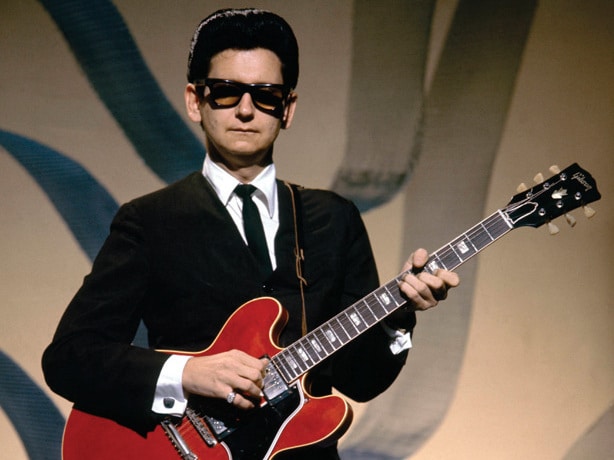
1963–64
Orbison eventually developed a persona and an image that did not reflect his personality. He had no publicist in the early 1960s, therefore he had little presence in fan magazines, and his single sleeves did not feature his picture. Life called him an “anonymous celebrity”. After leaving his thick eyeglasses on an airplane in 1963, while on tour with the Beatles, Orbison was forced to wear his prescription Wayfarer sunglasses on stage and found that he preferred them. His biographers suggest that although he had a good sense of humor and was never morose, Orbison was very shy and suffered from severe stage fright; wearing sunglasses helped him hide somewhat from the attention.
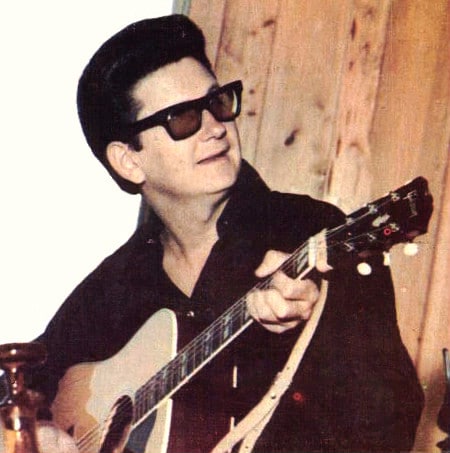
The ever-present sunglasses led some people to assume that the stationary performer was blind. His black clothes and the desperation in his songs emanated the image of mystery and introversion. His dark and brooding persona, combined with his tremulous voice in lovelorn ballads marketed to teenagers, made Orbison a star in the early 1960s. His string of top-40 hits continued with “In Dreams” (US number seven, UK number six), “Falling” (US number 22, UK number 9), and “Mean Woman Blues” (US number five, UK number three) coupled with “Blue Bayou” (US number 29, UK number three). According to the official Roy Orbison U.S. discography by Marcel Riesco, a rare alternate version of “Blue Bayou” was released only in Italy. Orbison finished 1963 with a Christmas song written by Willie Nelson, “Pretty Paper” (US number 15 in 1963, UK number six in 1964).
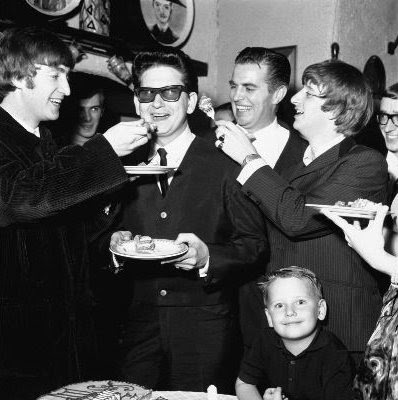
As “In Dreams” was released in April 1963, Orbison was asked to replace the guitarist Duane Eddy on a tour of the UK in top billing with the Beatles, whose popularity was on the rise. When he arrived in Britain, however, he saw the amount of advertising devoted to the quartet and realized he was no longer the main draw. He had never heard of them, and annoyed, asked rhetorically, “What’s a Beatle, anyway?” to which John Lennon replied, after tapping his shoulder, “I am”. On the opening night, Orbison opted to go onstage first, although he was the more established act. Known for having raucous shows expressing an extraordinary amount of energy, Lennon, Paul McCartney, George Harrison, and Ringo Starr stood dumbfounded backstage as Orbison performed completely still and simply sang through 14 encores. Finally, when the audience began chanting “We want Roy!” again, Lennon and McCartney prevented Orbison from going on again by physically holding him back. Starr later said, “In Glasgow, we were all backstage listening to the tremendous applause he was getting. He was just standing there, not moving or anything.” Through the tour, however, the two acts quickly learned to get along, a process made easier by the fact that the Beatles admired his work. Orbison felt a kinship with Lennon, but it was Harrison with whom he would later form a strong friendship.
Touring in 1963 took a toll on Orbison’s personal life. His wife Claudette began having an affair with the contractor who built their home in Hendersonville, Tennessee. Friends and relatives attributed the breakdown of the marriage to her youth and her inability to withstand being alone and bored. When Orbison toured Britain again in the fall of 1963, she joined him. He was immensely popular wherever he went, finishing the tour in Ireland and Canada. Almost immediately, he toured Australia and New Zealand with the Beach Boys and returned again to Britain and Ireland, where he was so besieged by teenaged girls that the Irish police had to halt his performances to pull the girls off him. He continued to tour, traveling to Australia again, this time with the Rolling Stones. Mick Jagger later remarked, referring to a snapshot he took of Orbison in New Zealand, “a fine figure of a man in the hot springs, he was.”
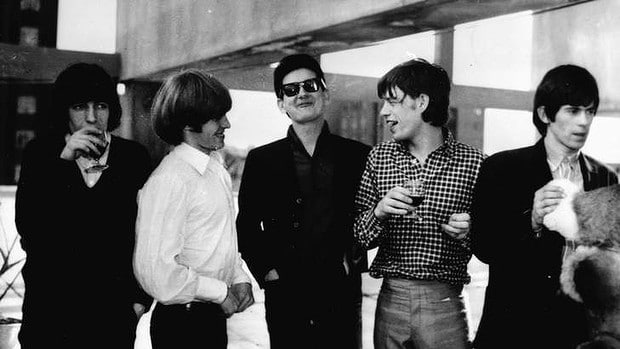
Orbison also began collaborating with Bill Dees, whom he had known in Texas. With Dees, he wrote “It’s Over”, a number-one hit in the UK and a song that would be one of his signature pieces for the rest of his career. When Claudette walked in the room where Dees and Orbison were writing to say she was heading for Nashville, Orbison asked if she had any money. Dees said, “A pretty woman never needs any money”. Just 40 minutes later, “Oh, Pretty Woman” was completed. A riff-laden masterpiece that employed a playful growl he got from a Bob Hope movie, the epithet mercy Orbison uttered when he was unable to hit a note, and a merging of his vulnerable and masculine sides, it rose to number one in the fall of 1964 in the United States and stayed on the charts for 14 weeks. It rose to number one in the UK, as well, spending 18 weeks total on the charts. The single sold over seven million copies. Orbison’s success was greater in Britain; as Billboard magazine noted, “In a 68-week period that began on August 8, 1963, Roy Orbison was the only American artist to have a number-one single in Britain. He did it twice, with ‘It’s Over’ on June 25, 1964, and ‘Oh, Pretty Woman’ on October 8, 1964. The latter song also went to number one in America, making Orbison impervious to the current chart dominance of British artists on both sides of the Atlantic.”
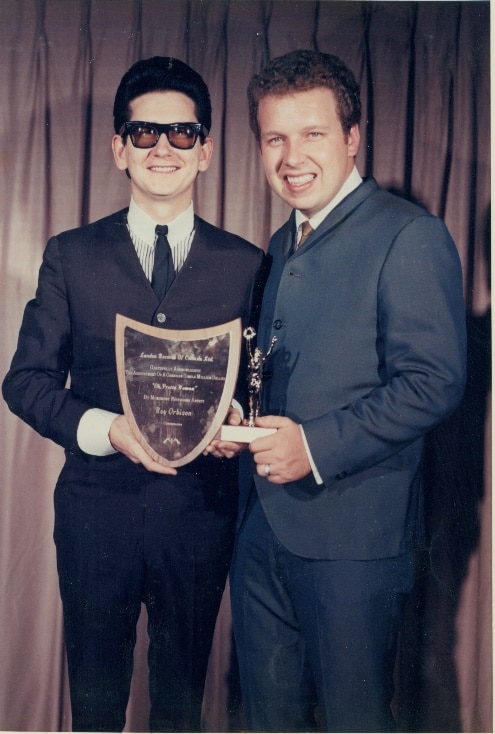
1965–69: Career decline and tragedies
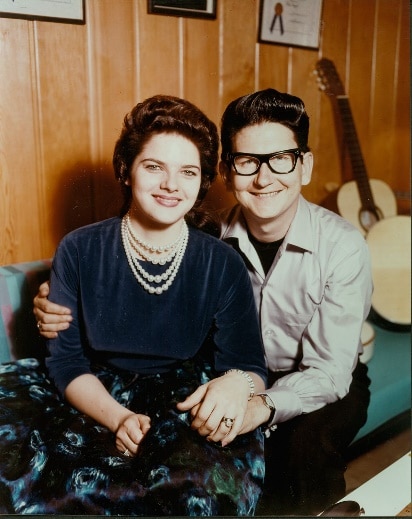
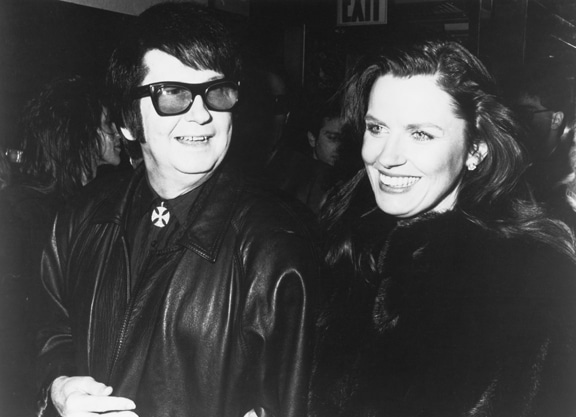
Following “Oh, Pretty Woman”, Orbison endured some upheavals. Claudette and he divorced in November 1964 over her infidelities, but the two reconciled 10 months later. His contract with Monument was expiring in June 1965. Wesley Rose, at this time acting as Orbison’s agent, moved him from Monument Records to Metro-Goldwyn-Mayer (MGM) (though in Europe he remained with Decca’s London Records) for $1 million, and the understanding that he would expand into television and films, as Elvis Presley had done. Orbison was a film enthusiast and, when not touring, writing or recording, would dedicate time to seeing up to three films a day.
Rose also became Orbison’s producer. Fred Foster later suggested that Rose’s takeover was responsible for the commercial failure of Orbison’s work at MGM. Engineer Bill Porter agreed that Orbison’s best work could only be achieved with RCA Nashville’s A-Team. Orbison’s first collection at MGM, an album titled There Is Only One Roy Orbison, sold fewer than 200,000 copies. With the onset of the British Invasion in 1964–65, the direction of popular music shifted dramatically, and most performers of Orbison’s generation were driven from the charts.
While on tour again in the UK in 1966, Orbison broke his foot falling off a motorcycle in front of thousands of screaming fans at a race track; he performed his show that evening in a cast. Claudette traveled to England to accompany Roy for the remainder of the tour. It was now made public that the couple had happily remarried and were back together (they had remarried in December 1965).
Orbison was fascinated with machines. He was known to follow a car that he liked and make the driver an offer on the spot. He had a large collection of cars by the late 1960s.
Orbison and Claudette shared a love for motorcycles; she had grown up around them, but he claimed Elvis Presley had introduced him to motorcycles. Tragedy struck on June 6, 1966, however, when Orbison and Claudette were riding home from Bristol, Tennessee. She struck the door of a pickup truck which had pulled out in front of her on South Water Avenue in Gallatin, Tennessee, and died instantly.
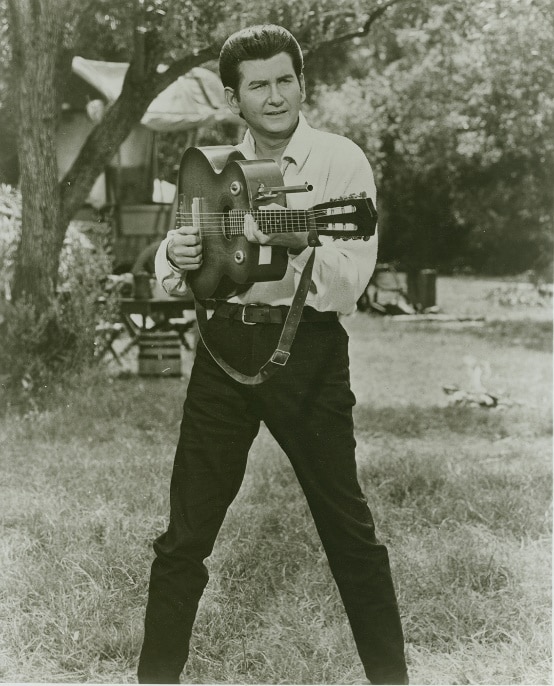
A grieving Orbison threw himself into his work, collaborating with Bill Dees to write music for The Fastest Guitar Alive, a film that MGM had scheduled for him to star in as well. It was initially planned as a dramatic Western but was rewritten as a comedy. Orbison’s character was a spy who stole, and had to protect and deliver, a cache of gold to the Confederate Army during the American Civil War, and was outfitted with a guitar that turned into a rifle. The prop allowed him to deliver the line, “I could kill you with this and play your funeral march at the same time”, Orbison was pleased with the film, although it proved to be a critical and box office flop. While MGM had included five films in his contract, no more were made.
He recorded an album dedicated to the songs of Don Gibson and another of Hank Williams covers, but both sold poorly. During the counterculture era, with the charts dominated by artists like Jimi Hendrix, Jefferson Airplane, the Rolling Stones, and the Doors, Orbison felt lost and directionless, later saying: ” didn’t hear a lot I could relate to so I kind of stood there like a tree where the winds blow and the seasons change, and you’re still there and you bloom again.”
During a tour of England and playing Bournemouth on Saturday, September 14, 1968, he received the news that his home in Hendersonville, Tennessee, had burned down, and his two eldest sons had died. The property was sold to Johnny Cash, who demolished the building and planted an orchard on it. On March 25, 1969, Orbison married German teenager Barbara Jakobs, whom he had met several days before his sons’ deaths. Wesley (born 1965), his youngest son with Claudette, was raised by Orbison’s parents. Orbison and Barbara had a son (Roy Kelton) in 1970 and another (Alexander) in 1975.
1970s–80s
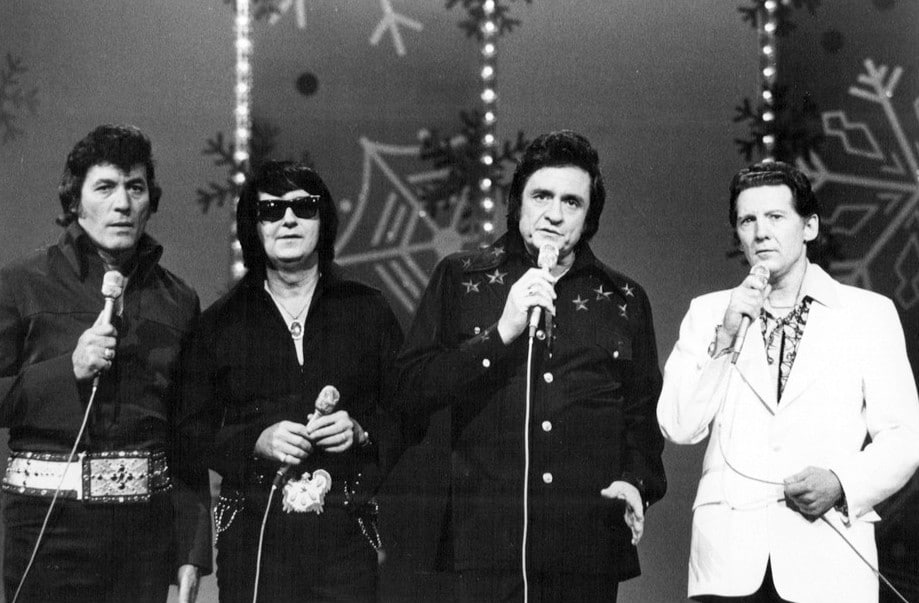
Orbison continued recording albums in the 1970s, but none of them sold more than a handful of copies, and by 1976, he had gone an entire decade without a charting album. Aside from a few minor hits in Australia, he also failed to produce any charting singles after the 1960s. His fortunes sank so low that he began to doubt his own talents and several of his 1970s albums were not released internationally due to low US sales. He left MGM Records in 1973 and signed a one-album deal with Mercury Records. Author Peter Lehman would later observe that his absence was a part of the mystery of his persona: “Since it was never clear where he had come from, no one seemed to pay much mind to where he had gone; he was just gone.” His influence was apparent, however, as several artists released covers of his songs, which proved popular. Orbison’s version of “Love Hurts”, a song composed by Felice and Boudleaux Bryant and first recorded by the Everly Brothers, was remade by Gram Parsons and Emmylou Harris, again by hard rock band Nazareth, and by blues adept Jim Capaldi. Sonny James sent “Only the Lonely” to No. 1 on the country music charts. Bruce Springsteen ended his concerts with Orbison songs, and Glen Campbell had a minor hit with a remake of “Dream Baby”.
A compilation of Orbison’s greatest hits went to No. 1 in the UK in January 1976. The same year, he began to open concerts for the Eagles, who started as Linda Ronstadt’s backup band. Ronstadt herself covered “Blue Bayou” in 1977, her version reaching No. 3 on the Billboard charts and remaining in the charts for 24 weeks. Orbison credited this cover in particular for reviving his memory in the popular mind, if not his career. He signed again with Monument in 1976 and recorded “Regeneration” with Fred Foster, but it proved no more successful than before.
In late 1977, Orbison was not feeling well and decided to overwinter in Hawaii. While there, he checked into a hospital where testing discovered that he had severely obstructed coronary arteries. On January 18, 1978, Orbison underwent a triple coronary bypass. He had suffered from duodenal ulcers since as early as 1960 and had been a heavy smoker since adolescence. He felt revitalized following the triple bypass, but he continued to smoke, and his weight fluctuated for the remainder of his life.
In 1980, Don McLean charted with “Crying” and his version unexpectedly went to the top of the charts at first in the Netherlands, afterward hitting No. 5 in the US and staying on the charts for 15 weeks; it was No. 1 in the UK for three weeks, and also topped the Irish Charts. Although he was all but forgotten in the US, Orbison reached the most unlikely places for a rock and roll legend, like Bulgaria for example in 1982. He was astonished to find that he was as popular there as he had been in 1964; he was forced to stay in his hotel room because he was mobbed on the streets of Sofia. In 1981, he and Emmylou Harris had won a Grammy Award for their duet “That Lovin’ You Feelin’ Again” (from the comedy film Roadie, in which Orbison also had a cameo role) and things were picking up. It was his first such award, and he felt hopeful in making a full return to popular music. However, it would be several more years until this came to fruition. In the meantime, Van Halen released a hard-rock cover of “Oh, Pretty Woman” on their 1982 album Diver Down, again further exposing a younger generation to Orbison’s legacy.
Career revival
By 1987, Orbison’s career was fully revived. He released an album of his re-recorded hits, titled In Dreams: The Greatest Hits. A song he recorded, “Life Fades Away”, written with his friend Glenn Danzig, was featured in the film Less Than Zero (1987). He and k.d. lang performed a duet of “Crying” for inclusion on the soundtrack to the film, Hiding Out (1987), winning a Grammy for Best Country Collaboration with Vocals.
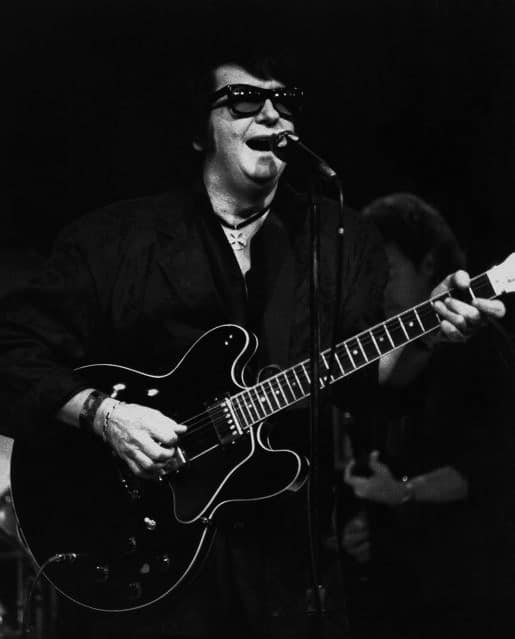
Also in 1987, Orbison was inducted into the Nashville Songwriters Hall of Fame and initiated into the Rock and Roll Hall of Fame by Bruce Springsteen, who concluded his speech with a reference to his own album Born to Run: “I wanted a record with words like Bob Dylan that sounded like Phil Spector—but, most of all, I wanted to sing like Roy Orbison. Now, everyone knows that no one sings like Roy Orbison.” In response, Orbison asked Springsteen for a copy of the speech, and said of his induction that he felt “validated” by the honor. A few months later, Orbison and Springsteen paired again to film a concert at the Cocoanut Grove nightclub in Los Angeles. They were joined by Jackson Browne, T Bone Burnett, Elvis Costello, Tom Waits, Bonnie Raitt, Jennifer Warnes, James Burton, and k.d. lang. Lang later recounted how humbled Orbison had been by the display of support from so many talented and busy musicians: “Roy looked at all of us and said, ‘If there is anything, I can ever do for you, please call on me’. He was very serious. It was his way of thanking us. It was very emotional.” The concert was filmed in one take and aired on Cinemax under the title Roy Orbison and Friends: A Black and White Night; it was released on video by Virgin Records, selling 50,000 copies.
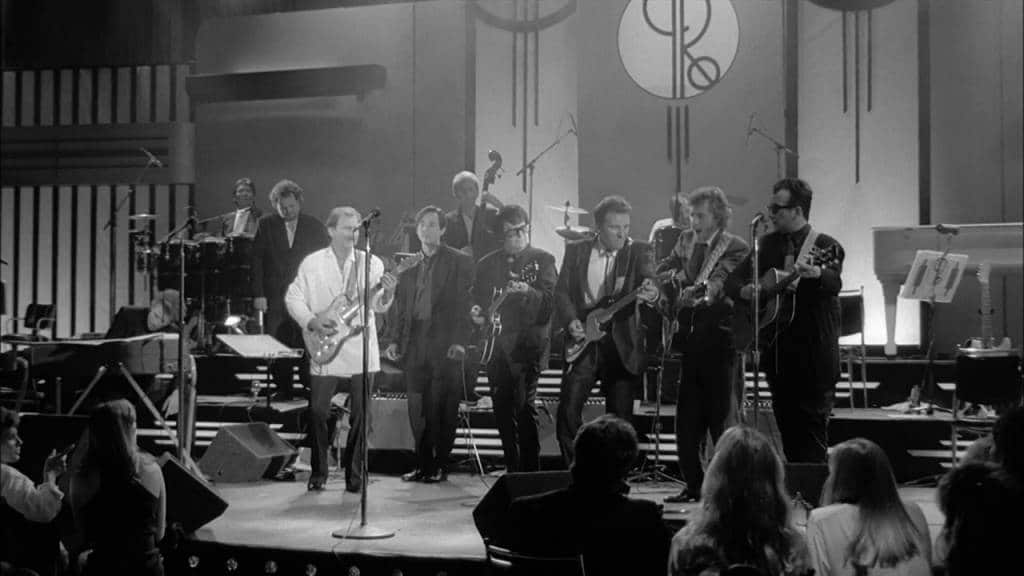
Traveling Wilburys and Mystery Girl
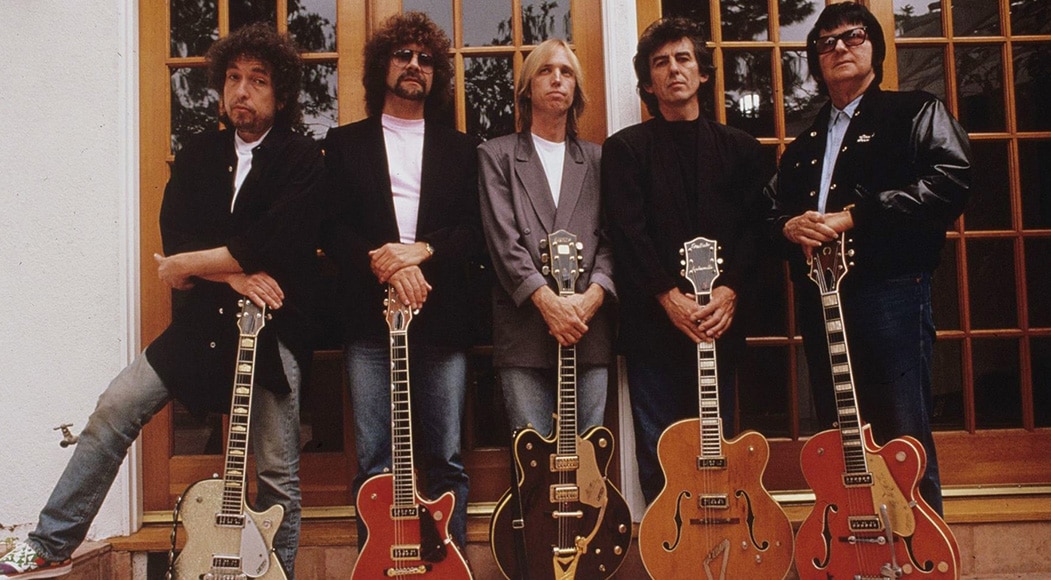
It was also in 1988 that Orbison began collaborating seriously with Electric Light Orchestra bandleader Jeff Lynne on a new album. Lynne had just completed production work on George Harrison’s Cloud Nine album, and all three ate lunch together one day when Orbison accepted an invitation to sing on a song of Harrison’s new single. They subsequently contacted Bob Dylan, who, in turn, allowed them to use a recording studio in his home. Along the way, Harrison made a quick visit to Tom Petty’s residence to obtain his guitar; Petty and his band had backed Dylan on his last tour. By that evening, the group had written “Handle with Care”, which led to the concept of recording an entire album. They called themselves the Traveling Wilburys, representing themselves as half-brothers with the same father. They gave themselves stage names; Orbison chose his from his musical hero, calling himself “Lefty Wilbury” after Lefty Frizzell. Expanding on the concept of a traveling band of raucous musicians, Orbison offered a quote about the group’s foundation in honor: “Some people say Daddy was a cad and a bounder. I remember him as a Baptist minister.”
Lynne later spoke of the recording sessions: “Everybody just sat there going, ‘Wow, it’s Roy Orbison!’… Even though he’s become your pal and you’re hanging out and having a laugh and going to dinner, as soon as he gets behind that [mic] and he’s doing his business, suddenly it’s shudder time.” Orbison was given one solo track, “Not Alone Any More”, on the album. His contributions were highly praised by the press. Traveling Wilburys Vol. 1 spent 53 weeks on the US charts, peaking at number three. It reached No. 1 in Australia and topped out at No. 16 in the UK. The album won a Grammy for Best Rock Performance by a Duo or Group. Rolling Stone included it in the top 100 albums of the decade.
Orbison was in high demand for concerts and interviews once again, and was seemingly ecstatic about it. He began writing songs and collaborating with many musicians from his past and newer fans, to develop a solo album, Mystery Girl.
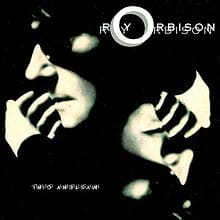
Mystery Girl was co-produced by Jeff Lynne, whom Orbison considered the best producer he had ever collaborated with. Elvis Costello, Orbison’s son Wesley and others offered their songs to him. The biggest hit from the album was “You Got It”, written with Lynne and Tom Petty. It posthumously rose to No. 9 in the US and No. 3 in the UK.
In 2014, a demo of Orbison’s “The Way Is Love” was released as part of the 25th-anniversary deluxe edition of Mystery Girl. The song was originally recorded on a stereo cassette player around 1986. Orbison’s sons contributed instrumentation on the track along with Roy’s vocals; it was produced by John Carter Cash.
Although the video for the Wilburys’ “Handle with Care” was filmed with Orbison, the video for “End of the Line” was filmed and released posthumously. During Orbison’s vocal parts in “End of the Line”, the video shows a guitar in a rocking chair, next to Orbison’s framed photo.
Death
Orbison determinedly pursued his second chance at stardom, but he expressed amazement at his success: “It’s very nice to be wanted again, but I still can’t quite believe it.” He lost some weight to fit his new image and the constant demand of touring, as well as the newer demands of making videos. In the final three months of his life, he gave Rolling Stone magazine extensive access to his daily activities; he intended to write an autobiography and wanted Martin Sheen to play him in a biopic. In November 1988, Mystery Girl was completed, and Traveling Wilburys Vol. 1 was rising up the charts. Around this time, Orbison confided in Johnny Cash that he was having chest pains and said he would have to do something about his health, but he never did. He went to Europe, was presented with an award there, and played a show in Antwerp, where footage for the video for “You Got It” was filmed. He gave several interviews a day in a hectic schedule. A few days later, a manager at a club in Boston was concerned that he looked ill, but Orbison played the show, to another standing ovation.
Orbison performed at the Front Row Theater in Highland Heights, Ohio, on December 4. Exhausted, he returned to his home in Hendersonville to rest for several days before flying again to London to film two more videos for the Traveling Wilburys. On December 6, he spent the day flying model airplanes with his sons and ate dinner at his mother’s home in Hendersonville. Later that day, he died of a heart attack, at the age of 52.
The tabloid National Enquirer suggested on its cover that Orbison had worked himself to death. A memorial was held in Nashville, and another in Los Angeles. He was buried at Westwood Village Memorial Park Cemetery in an unmarked grave. On April 8, 1989, Orbison became the first deceased musician since Elvis Presley to have two albums in the US Top Five at the same time, with the Traveling Wilburys album at number 4 and his own Mystery Girl at number 5. In the United Kingdom, he achieved even greater posthumous success, with two solo albums in the Top 3 in the chart dated February 11, 1989, Mystery Girl at number 2 and the compilation The Legendary Roy Orbison at number 3.
